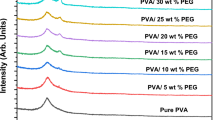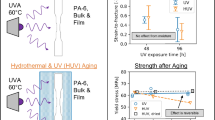Abstract
A technique based on the tensile testing is proposed for a quantitative characterization of materials with a wide strain range and nonlinear stress and strain dependencies which can be represented as two sequential processes (stages) described in Hollomon power-like approximation. The distinct and unambiguous criterion is developed to determine the transition between these processes associated with prevailing deformation events (process I) or following it process II with dominating failure events. The method is tested for ethylene vinyl acetate (EVA) copolymer used widely as the encapsulant material for photovoltaic (PV) modules. The values of activation energies and structural factors (as defined by Zhurkov equation relating the creep time to the tensile stress applied) were derived for each of the stages and two sets of the EVA samples with various levels of the cross-linking. The activation energies are determined to differ slightly for each stage regardless the sample treatment, whereas the structural factors have specific values indicating a higher stress concentration level for the initial stage as compared to that for the final process II. The research results are in the appropriate consistency with the existing concepts available for the polymer failure and with the data of the complementary techniques applied in this research: (1) broadband proton nuclear magnetic resonance (1H NMR); (2) attenuated reflection Fourier-transform infrared spectroscopy (ATR-FTIR); (3) fractographic and optical microscopy. The approach allows one to get the parameters applicable for prediction of a material behavior under the creep and aging.
Graphical Abstract








Similar content being viewed by others
References
Henderson AM (1993) Ethylene-Vinyl Acetate (EVA) Copolymers: A General Review. IEEE El Insul Mag 9(1):30–38. https://doi.org/10.1109/57.249923
Czanderna AW, Pern FJ (1996) Encapsulation of PV modules using ethylene vinyl acetate copolymer as a pottant: A critical review. Sol En Mater and Solar Cells 43:101–181. https://doi.org/10.1016/0927-0248(95)00150-6
Jiang S, Wang K, Zhang H, Ding Y, Yu Q (2015) Encapsulation of PV Modules Using Ethylene Vinyl Acetate Copolymer as the Encapsulant. Macromol React Eng 9:522–529. https://doi.org/10.1002/mren.201400065
Yang HE (2019) Overview: Durability and Reliability of Common PV Module and Polymers/Materials. In: Yang HE, French RH, Bruckman LS (eds.) Durability and Reliability of Polymers and Other Materials in Photovoltaic Modules Elsevier pp. 23–45 https://doi.org/10.1016/B978-0-12-811545-9.00002-1
Hirschl Ch, Biebl-Rydlo M, DeBiasio M, Mühleisen W, Neumaier L, Scherf W, Oreski G, Eder G, Chernev B, Schwab W, Kraft M (2013) Determining the degree of crosslinking of ethylene vinyl acetate photovoltaic module encapsulants–A comparative study. Sol En Mater Sol Cells 116:203–218. https://doi.org/10.1016/j.solmat.2013.04.022
Hirschl Ch, Neumaier L, Mühleisen W, Zauner M, Oreski G, Eder GC, Seufzer S, Berge Ch, Rüland E, Kraft M (2016) In-line determination of the degree of cross linking of ethylenevinyl acetate in PV modules by Raman spectroscopy. Sol En Mater Sol Cells 152:10–20. https://doi.org/10.1016/j.solmat.2013.04.022
Kajari-Schröder S, Eitner U, Oprisoni C, Alshuth T, Köntges M, Brendel R (2010) Modelling the curing dynamic of ethylene-vinyl acetate. In: Proc 25th EUPVSEC/WCPEC-5. Valencia, Spain, pp 4039–4043. https://doi.org/10.4229/25thEUPVSEC2010-4AV.3.25
Sisanth KS, Thomas MG, Abraham J, Thomas S (2017) General introduction to rubber compounding. In: Thomas S, Maria HJ (eds.) Progress in Rubber Nanocomposites, Elsevier, Woodhead Publishing, pp. 1–38 https://doi.org/10.1016/B978-0-323-39408-6.00011-X
McKeen LW (2017) Polyvinyls and Acrylics. In: Film properties of plastics and elastomers, 4th edn., Elsevier, William Andrew, pp. 273–316. https://doi.org/10.1016/B978-0-12-813292-0.00010-1
Sharma BK, Desai U, Singh A, Singh A (2020) Effect of vinyl acetate content on the photovoltaic-encapsulation performance of ethylene vinyl acetate under accelerated ultra-violet aging. J Appl Polym Sci 137(2):48268
Choi SS, YuYe C (2021) Change of Crystalline Properties of Poly(ethylene-co-vinyl acetate) according to the Microstructures. Elastom Compos 56(2):92–99. https://doi.org/10.7473/EC.2021.56.2.92
Ramírez-Hernández A, Aguilar-Flores C, Aparicio-Saguilán A (2019) Fingerprint analysis of FTIR spectra of polymers containing vinyl acetate. Dyna 86(209):198–205
Chamberlin CE, Rocheleau MA, Marshall MW, Reis AM, Coleman NT, Lehman PA (2011) Comparison of PV module performance before and after 11 and 20 years of field exposure. 37th IEEE Photovoltaic Specialists Conference, IEEE, Seattle, WA, USA, pp. 000101–000105. https://doi.org/10.1109/PVSC.2011.6185854
Ndiaye A, Charki A, KobiKe´be´ ACMF, Pape A, Ndiaye PA, Sambou V (2013) Degradations of silicon photovoltaic modules: A literature review. Sol En 96:140–151. https://doi.org/10.1016/j.solener.2013.07.005
Zielnik AF, Burns DM (2019) Service Life Prediction of PV Materials. In: Yang HE, French RH, Bruckman LS (ed.) Durability and Reliability of Polymers and Other Materials in Photovoltaic Modules, Elsevier, pp. 297–328. https://doi.org/10.1016/B978-0-12-811545-9.00013-6
Omazic A, Oreski G, Halwachs M, Eder GC, Hirschl C, Neumaier L, Pinter G, Erceg M (2019) Relation between degradation of polymeric components in crystalline silicon PV module and climatic conditions: A literature review. Sol En Mater Sol Cells 192:123–133. https://doi.org/10.1016/j.solmat.2018.12.027
Oreski G, Wallner GM (2009) Evaluation of the aging behavior of ethylene copolymer films for solar applications under accelerated weathering conditions. Sol En 83:1040–1047. https://doi.org/10.1016/j.solener.2009.01.009
Oliveira MCC, Diniz ASA, Viana MM, Lins VFC (2018) The causes and effects of degradation of encapsulant ethylene vinyl acetate copolymer (EVA) in crystalline silicon photovoltaic modules: A review. Renew Sustain Energy Rev 81:2299–2317. https://doi.org/10.1016/j.rser.2017.06.039
Oliveira MCC, Cassini DA, Diniz ASA, Soares LG, Viana M, Kazmerski L, Lins VFC (2019) Comparison and analysis of performance and degradation differences of crystalline-Si photovoltaic modules after 15-years of field operation. Sol En 191:235–250. https://doi.org/10.1016/j.solener.2019.08.051
Park NC, Jeong JS, Kang BJ, Kim DH (2013) The effect of encapsulant discoloration and delamination on the electrical characteristics of photovoltaic module. Microelectron Reliab 53:1818–1822. https://doi.org/10.1016/j.microrel.2013.07.062
Singh KA, Kumar D, Jindal P (2020) Influence of Graphene on Mechanical Behavior of EVA Composite at Low Strain Rate Loading. In: Prakash C, Singh S, Krolczyk G, Pabla BS (eds.) Advances in Materials Science and Engineering, Lecture Notes in Mechanical Engineering, Springer, Singapore, pp. 261–270. https://doi.org/10.1007/978-981-15-4059-2_21
Ponnamma D, Sadasivuni KK, Grohens Y, Guo Q, Thomas S (2014) Carbon nanotubes based elastomer composites-an approach towards multifunctional materials. J Mater Chem C 2:8446–8485. https://doi.org/10.1039/C4TC01037J
Yamane S, Ata S, Chen L, Sato H, Yamada T, Hata K, Mizukado J (2017) Experimental analysis of stabilizing effects of carbon nanotubes (CNTs) on thermal oxidation of poly(ethylene glycol)–CNT composites. Chem Phys Lett 670:32–36. https://doi.org/10.1016/j.cplett.2016.12.071
de Oliveira MC, Soares LG, Viana MM, Diniz AS, Lins VD (2020) Development of ethylene-vinyl acetate copolymer/graphene oxide nanocomposites for crystalline silicon photovoltaic modules. Int J Adhes Adhes 100:102595. https://doi.org/10.1016/j.ijadhadh.2020.102595
Sadiku ER, Reddy AB, Gnanasekarana D, Oboirien B, Aderibigbe BA, Varaprasad K, Goddeti SMR (2016) Nanostructured polymer blend for gas/vapour barrier and dielectric applications. In: Shanks R, Chandrasekharakurup S (eds) Thomas S. Design and Applications of Nanostructured Polymer Blends and Nanocomposite Systems, Elsevier, pp 240–259
Wang X, Nshimiyimana JP, Huang D, Diao X, Zhang N (2021) Durable superhydrophilic and antireflective coating for high-performance anti-dust photovoltaic systems. Appl Nanosci 11:875–885. https://doi.org/10.1007/s13204-020-01643-0
Gopalakrishna H, Sinha A, Dolia K, Jordan D, Tamizhmani G (2019) Nondestructive characterization and accelerated UV testing of browned field-aged PV modules. IEEE J Photovolt 9:1733–1740. https://doi.org/10.1109/JPHOTOV.2019.2927920
Plota A, Masek A (2020) Lifetime prediction methods for degradable polymeric materials—a short review. Materials 13(20):4507
Zhurkov SN (1965) Kinetic concept of the strength of solids. Int J Fract Mech 1:311–323. https://doi.org/10.1007/BF03545562
Smith CW, Wootton RJ, Evans KE (1999) Interpretation of experimental data for Poisson’s ratio of highly nonlinear materials. Exp Mech 39:356–362. https://doi.org/10.1007/BF02329817
Onaka S (2012) Appropriateness of the hencky equivalent strain as the quantity to represent the degree of severe plastic deformation. Mater Trans 53(8):1547–1548. https://doi.org/10.2320/matertrans.M2012077
Regel’ VR, Slutsker AI, Tomashevskiĭ ÉE (1972) The kinetic nature of the strength of solids. Sov Phys Usp 15(1):45–65. https://doi.org/10.1070/pu1972v015n01abeh00
Gillen KT, Celina M (2001) The wear-out approach for predicting the remaining lifetime of materials. Polym Deg Stab 71:15–30. https://doi.org/10.1016/S0141-3910(00)00112-9
Freed AD, Leonov AI (2002) The bailey criterion: statistical derivation and applications to interpretations of durability tests and chemical kinetics. Z Angew Math Phys 53:160–166. https://doi.org/10.1007/s00033-002-8148-5
Zhao H, Aluru NR (2010) Temperature and strain-rate dependent fracture strength of graphene. J Appl Phys 108(6):064321
Kinloch AJ, Young RJ (1995) Molecular aspects. Fracture Behaviour of Polymers. Springer Science+Business Media, Dordrecht, pp 43–73. https://doi.org/10.1007/978-94-017-1594-2_2
Jaunich M, Böhning M, Braun U, Teteris G, Stark W (2016) Investigation of the curing state of ethylene/vinyl acetate copolymer (EVA) for photovoltaic applications through a combination of gel content determination, rheology, DSC and FTIR. Pol Test 52:133–140. https://doi.org/10.1016/j.polymertesting.2016.03.013
Rabek JF (1995) Experimental methods in polymer degradation. Polymer Photodegradation. Springer, Dordrecht, pp 433–598. https://doi.org/10.1007/978-94-011-1274-1_10
McKeen LW (2017) Introduction to the Mechanical, Thermal, and Permeation Properties of Plastics and Elastomer Films. Film properties of plastics and elastomers, 4th edn. Elsevier, William Andrew, pp 25–64. https://doi.org/10.1016/B978-0-12-813292-0.00002-2
Egorov EA, Zhizhenkov VV (1982) NMR studies of molecular mobility in uniaxially stretched oriented polymers. J Pol Sci Pol Phys Ed 20(7):1089–1106. https://doi.org/10.1002/pol.1982.180200701
Egorov EA, Zhizhenkov VV, Zakrevskii VA (1993) Broad line NMR study of molecular motion in uniaxially stretched polymers. Makromol Chem Macromol Symp 72(1):47–66. https://doi.org/10.1002/masy.19930720106
Saalwächter K, Spiess HW (2012) Solid-State NMR of Polymers. In: Matyjaszewski K, Möller M (eds.) Polymer Science: A Comprehensive Reference 2: pp.185–219. https://doi.org/10.1016/B978-0-444-53349-4.00025-X
Regel’ VR, Leksovsky AM (1967) A study of fatigue within the framework of the kinetic concept of fracture. Int J Fract 3:99–109. https://doi.org/10.1007/BF00182688
Gladysz GM, Chawla KK (2015) Intrinsic voids in polymers. In: Voids in Materials. From Unavoidable Defects to Designed Cellular Materials. Pp. 37–48 https://doi.org/10.1016/B978-0-444-56367-5.00003-8
Hollomon JH (1945) Tensile deformation Trans AIME 162:268–290
Nutor RK, Adomako NK, Fang YZ (2017) Using the hollomon model to predict strain-hardening in metals. Am J Mater Synth Process 2(1):1–4. https://doi.org/10.11648/j.ajmsp.20170201.11
Regel VR (1964) Mechanical models of polymers containing breakdown elements. Polym Sci USSR 6(3):437–442. https://doi.org/10.1016/0032-3950(64)90165-0
Okada T, Ikushige T (1977) 1H-NMR spectra of ethylene-vinyl acetate copolymers in the presence of shift reagent. Polym J 9(2):121–126. https://doi.org/10.1295/polymj.9.121
Kim E, Choi SS (2015) Comparison of vinyl acetate contents of poly(ethylene-co-vinyl acetate) analyzed by IR, NMR, and TGA. Elastom Compos 50(1):18–23. https://doi.org/10.7473/EC.2015.50.1.018
Kausch HH (1978) Polymer fracture. Springer, Berlin, Heidelberg, New York
Acknowledgements
The project has been supported by National Academy of Sciences of Ukraine (Grant No. 0121U107569).
Author information
Authors and Affiliations
Corresponding author
Ethics declarations
Conflict of interest
The author declares that there is no conflict of interest.
Additional information
Handling Editor: David Cann.
Publisher's Note
Springer Nature remains neutral with regard to jurisdictional claims in published maps and institutional affiliations.
Supplementary Information
Below is the link to the electronic supplementary material.
Rights and permissions
Springer Nature or its licensor (e.g. a society or other partner) holds exclusive rights to this article under a publishing agreement with the author(s) or other rightsholder(s); author self-archiving of the accepted manuscript version of this article is solely governed by the terms of such publishing agreement and applicable law.
About this article
Cite this article
Kislyuk, V.V., Shyvaniuk, V.M., Trachevskij, V.V. et al. Mechanical properties of the encapsulant material for photovoltaics. J Mater Sci 57, 21117–21134 (2022). https://doi.org/10.1007/s10853-022-07900-7
Received:
Accepted:
Published:
Issue Date:
DOI: https://doi.org/10.1007/s10853-022-07900-7




